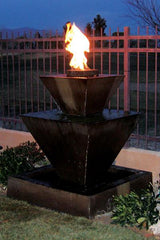Prepare your outdoor fountains and water features for freezing temperatures
Many states see below freezing temperatures during winter months. This exposes your outdoor fountain and statue display to prolonged periods of harsh weather. Fountains made of real stones like Marble or granite and even man-made cast stone and GFRC concrete are very sturdy and made to withstand harsh weather elements. Yet they can suffer from the expansion of the water logged within their pores and corners. The pump can experience issues when left exposed during the winter months.
But don’t worry, you can take some simple steps to protect your fountain and pump during Winter. Take the below steps to Winterize your fountain before ice temperature sets in, keeping it safe all winter long. This adds years to your fountain and you can enjoy it for a lifetime.
3 most important tips to winterizing outdoor fountains
- Drain the fountain – One of the most important steps you can take is to drain the water from the fountain and it pool. Remember water expands when it turns into ice. Water logged in its pores and corners expand and can cause pressure and cracks on the fountain.
Tip: Submerse the pump in a bucket of water and store away in a ware dry place where the water will not freeze. This helps to keep the seals wet and prevent the impeller from sticking.
- Remove the Pump – Pump is the heart of the fountain and is crucial to be protected. Unplug the pump from its power source. Pay attention to any pipes, tubing and any other pieces where water is involved. Remove any water from the pipes and tubing as well. While dismantling the pump and tubings, it’s a great opportunity to deep clean you pump before storing it away.
- Avoid water getting in, Cover or Put away the fountain – Once you have drained any existing water on your fountain and have cleaned and dried your fountain, take steps to avoid additional water getting into the Fountain. Below are some ways you can achieve this.
- Dismantle and put away – One of the easiest tip is to dismantle the fountain pieces and store it in a warm and dry place like a garage or shed. If the fountain or water feature is small, the whole feature can be stored away. Some large fountains, especially tiered ones, can be dismantled and stored in pieces as well.
- Cover the fountain – Fountains that are permanent features or too large to be brought in, can be covered. Covering a fountain goes a long way as it stops additional water getting in and freezing in the winter.
- Waterproof Covers – A waterproof cover gives the best protection for your fountain as it keeps moisture away. Outdoor fountain covers are UV stabilized, come in many sizes and have drawstring to Velcro to fasten the bottom providing ultimate protection. You can order custom size for you fountain to best fit its size.
- Alternate covering – If you don’t have a waterproof fountain cover you can consider some alternate covering to protect your fountain during the winter. Consider using a tarp to cover the fountain from the top. Alternately you can consider using other absorbent materials to avoid the water from entering the fountain.
Winterizing Ceramic Vase Outdoor Fountains
Ceramic Vase fountain are very popular as they add a contemporary look to your outdoors while also adding a pop of color. Our Ceramic vase fountains are patent protected and manufactured specially to withstand a fountains water pressure. Ceramic Vases, even the ones for fountains need care and protection during the harsh wither months. Follow these steps to winterize your Ceramic Vase fountain
- Remove the Pump – This is the most important step. Unplug the pump from the electrical and water supply outlets. Disassemble it and clean the pump and its parts before storing it away. Submerse the pump in a bucket of water and store away in a ware dry place where the water will not freeze. This helps to keep the seals wet and prevent the impeller from sticking.
- Do not drain the Underground Basin – Contrary to popular belief, its best to NOT drain the underground basin. It is best to keep the underground basin filled with water to avoid frost heaving during the freezing of the soil around the basin
- Drain the water in the vases – Do not allow any water to sit in the Ceramic vases and freeze.
- Store away – Most Vases are portable and can be stored away in a warm dry place. Move the Ceramic vases, copper piping and any tubing indoors to protect from freezing in the winters.
- Cover the fountain – if its not possible to dismantle and store the fountain in a arm dry place, consider covering the fountain. You can use a Waterproof cover or a trap to cover the fountain. Any cover that repels water and does not allow water buildup will work well.
Winterizing Basalt and Real Stone fountains
Mother nature is a bit kinder to natural stones. Basalt, granite and other natural stones have a better capacity to withstand freezing temperatures. It’s easy to winterize them.
- Remove the Pump - The most important this is to unplug the pump and tubings from the fountain and water source. Then store them away is a dry cool place.
- Do not drain the Underground Basin – Contrary to popular belief, its best to NOT drain the underground basin. It is best to keep the underground basin filled with water to avoid frost heaving during the freezing of the soil around the basin
- Cover -. Though these fountains can face harsh weather covering them provides the best protection. But it is not necessary to cover them. They will survive if left uncovered all through the winter.
Winterizing Cast Stone and GFRC concrete Outdoor Fountain
Many garden and courtyard fountains are made of Cast Stone concrete or Glass Fiber Reinforced Concrete (GFRC). These man-mad concrete formations can be very durable and sturdy adding great charm to your outdoors.
These concrete fountains can be porous and water gets logged in them. Usually this does not cause any issue but in the winter months, when ice forms and expands, can cause the concrete to crack.
- Seal and reinforce the foundation – Even before you place an outdoor fountain make sure the foundation is sealed and reinforced. This process ensures that the ground water is not absorbed by the Concrete fountain placed about it. Sealing the foundation keeps the moisture from seeping into the fountain.
- Concrete Surface Sealant – Usually a concrete surface sealant will already be applied to your fountain. Over the years it’s a good idea to check on this coat and resurface the sealant. This step will go a long way in protecting your outdoor concrete fountain
- Winterize your Fountain – The 3 main steps noted above are essential to Winterize your fountain.
- Drain the water
- Remove the pump and tubing
- Cover the fountain
Conclusion:
Winterize your Outdoor fountain by following these 3 easy steps before the first frost sets in. Caring for your fountain and protecting them against harsh winter temperatures adds years of life to them. You can enjoy your outdoor water feature and fountain for a lifetime!
- Drain the water in the fountain and pool basin
- Remove the pump and tubing from its electrical and water source. Store away in warm & dry place
- Avoid water seeping into the fountain. Covering the fountain is one of the best ways to ensure its protection. You can also dismantle and store away smaller fountains for the winter.













































































